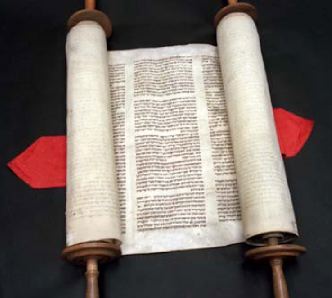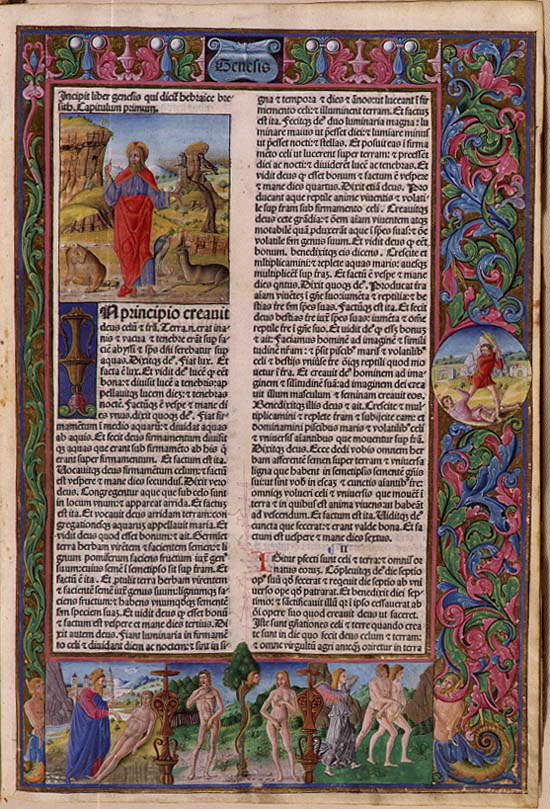 |
Fall ... |
 |
 |
Fall ... |
 |
Audience: Students interested in the history of Judaism, Christianity, or religious scriptures generally and wanting to fill Humanities and Writing Intensive core requirements, as well as majors and minors in Religion, Jewish Studies, History, and Literature. Prerequisites/Co-requisites: None. Course description: The Torah/Pentateuch (the first five books of Jewish and Christian scriptures) was the first part of the Bible to be regarded as scripture. It has also been central role to modern debates about the nature of scripture. This seminar will investigate how the Pentateuch became the Torah, the first Jewish scripture. It will examine critical issues in the modern study of the Torah/Pentateuch, such as its origins, composition, literary form, and canonization, and also its rhetorical use, performance in various media, and ritual function as a sacred object. The discussions will take up these issues alongside a close reading of the Torah/Pentateuch. After taking this course, students will be able to:
|
|
Course Requirements: Readings & Discussion: Students are expected to be prepared to discuss in class all the required readings. To facilitate these discussions, every student must write a short (1-3 sentences) comment or question about each of the assigned readings (including student reports) for that day, and hand it in via Blackboard one hour before class. Reports: Each student will (1) write a 5-8 page (1,500 words) paper analyzing the major interpretive issues in one Pentateuchal text assigned for class discussion and distribute it to the class via e-mail on the Friday before the relevant seminar, and (2) write and distribute in the same way a 5-8 page (1,500 words) report on one book from the list of critical studies or the list of histories of interpretation, describing its significance for interpretation of the Torah/Pentateuch and/or the Bible generally. Research Papers: In addition, students may write a substantive and original research paper on a subject related to the course topic, which must be submitted in four stages: (1) a statement of the topic, (2) a 100 word description including a thesis statement, outline and preliminary bibliography, (3) a class presentation of a summary during the last class meeting, (4) the finished research paper of 3,000 words due on or before December 15th. Or students may choose instead to write two additional 5-8 page reports (for a total of four papers of 1,5000 words each) on an additional text or book (due on the date for that text or book listed below). Unexcused late papers and reports will not be eligible for "A" grades. (Link to more detailed paper instructions.) The students' work will be evaluated on the basis of class participation (10%) and the daily reading questions or comments (10%), the two shorter papers (20% each), and the final research paper or two additional shorter papers (40%). Academic Integrity Policy: Disability-Related Accommodations Religious Observances Policy |
Topics and Readings: |
||||||
| Day | Topic | Texts |
| M Aug 27 | Introductions | |
|
W Aug 29 |
Ezra: when the Pentateuch became Scripture (Torah) | Primary: Nehemiah 8 Secondary: * "Ezra" & K&L, introduction & ch. 1 |
| M Sep 3 | Labor Day | No Class |
|
|
||
| W Sep 5 | Rhetoric of Origins: World | Primary: Gen 1-11 Secondary: K&L, pp. 65-76 |
|
M Sep 10 |
Rhetoric of Origins: Israel | Primary:
Gen 12-50; Exod 1-19; Deut 1-11 Secondary: K&L, pp. 76-100 |
| W Sep 12 | Rhetoric of Origins: Tabernacle/Temple | Primary:
Exod 25-40 Secondary: K&L, pp. 100-109 Book Reports: Damrosch, "Leviticus" |
|
M Sep 17 |
Rhetoric of Origins: Priests | Primary: Lev 1-16; Num
11-20 Secondary: K&L, pp. 124-140 |
| W Sep 19 | Rhetoric of Law | Primary: Exod 19-24; Lev
17-27; Deut 12-26 Secondary: K&L, pp. 110-123, 141-151 |
|
M Sep 24 |
Rhetoric of Threat and Promise | Primary: Lev 26; Deut 27-34
Secondary: K&L, pp. 152-163 |
|
|
||
|
W Sep 26 |
After Ezra: Rhetoric of Identity: Hasmoneans, Christians, Rabbis, Samaritans | Primary: Sir ; 1 Macc ; Heb ; Secondary: * Carr |
|
M Oct 1 |
After Ezra: Rhetoric of Law: 2T; Rabbinic; Byzantine, Maimonides; Gratian; Ten Commandments | Primary: Chr; Jub; 1QT; |
|
W Oct 3 |
After Ezra: Rhetoric of Origins 1: ancient interp.; halakhah and Haggadah; typology & allegory | Secondary: * Kugel |
|
M Oct 8 |
After Ezra: Rhetoric of Origins 2: plain meaning (peshat), astronomy & evolution; archeology and the ANE | Secondary: * Greenberg, * Finckelstein |
| W Oct 10 | After Ezra: Rhetoric of Origins 3: historical to post-modern criticisms | Secondary: Levenson, ch. 1; * Smith |
|
M Oct 15 |
Before Ezra: Rhetoric of Promise & Threat | Primary: review Deut 27-34; * ANE
treaties, historical psalms Secondary: * Mendenhall |
|
W Oct 17 |
Before Ezra: Rhetoric of Law | Primary: Numbers; * Hammurabi's Code |
|
M Oct 22 |
Before Ezra: Rhetoric of Origins 4: Aaron and the history of priesthood | Primary: review Leviticus |
| W Oct 24 | Before Ezra: Rhetoric of Origins 3: Moses | Primary: review Exodus 1-19,
Deuteronomy Secondary: Levenson, ch. 6 |
|
M Oct 29 |
Before Ezra: Rhetoric of Origins 2: traditions about ancestors | Primary: review Genesis 12-50 Secondary: Levenson, ch. 5 |
| W Oct 31 | Before Ezra: Rhetoric of Origins 1: creation & world order | Primary: ANE myths & epics,review
Genesis 1-11 Secondary: Blenkinsopp, ch. 1 |
|
|
||
|
M Nov 5 |
After Ezra: Judaism, Hellenism, language (Hebrew) | Primary: 2 Maccabees Secondary: * Carr, * Sawyer |
|
W Nov 7 |
After Ezra: Recitation, cantonation, chant, song; lectio divina | Primary: Josephus, Antiquities
16:43; Apion 2:175; Luke 4:16-17; Acts 13:13-15;
Theodotus inscription; m. Yoma 7:1; m. Sot.
7:7,8 Secondary: |
|
M Nov 12 |
After Ezra: art, theater, film (illuminated mss b/w icon & performance) | Primary: (web links to manuscripts)
Secondary: * Brown |
| W Nov 14 | Before Ezra: ancient scribes, ritual | Primary: Exod 24; Deut 5, 31; 2 Kgs
22-23; Neh 8 Secondary: * Carr |
| Nov17-23 | Thanksgiving Break | No class |
|
|
||
|
M Nov 26 |
After Ezra: Scrolls, Mezuzahs, Bamahs |
Primary: 1 Macc 1:56-57; Josephus Ant.
16:164; 20:115; m. Meg. 3.1 |
|
W Nov 28 |
After Ezra: Translations, Gospels, Oaths, Desecrations | Primary: Sira 24:23; Baruch 4:1;
Aristeas; Acts 7:53; ’Abot 3:14; 5:6; Gen.
Rab. 1:1 Secondary: * Van der Toorn, * Parmenter, * Sabar |
|
M Dec 3 |
After Ezra: Illuminations, Printing, Mass production, Relic texts |
Secondary: * Brown, * Hamel, *Marty, *Stolow |
|
W Dec 5 |
Before Ezra: Ark, Tablets, Ritual Texts | Primary: Exod 24,32; Josh 8; Judg 2-4;
Deut 6, 31 Secondary: Egyptian lector priests; |
| Dec 17 | Final Papers Due | |
| Course Bibliography: Critical Studies, More Studies, Histories of Interpretation, Commentaries, Critical Studies (possible book reports):
|